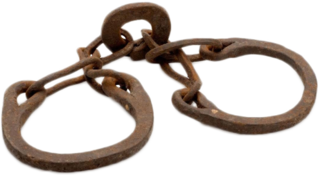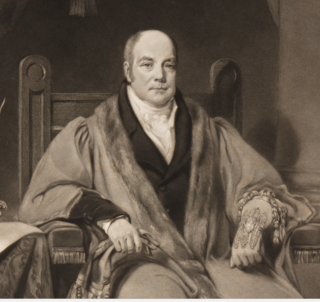Related Research Articles

The Atlantic slave trade or transatlantic slave trade involved the transportation by slave traders of enslaved African people to the Americas. European slave ships regularly used the triangular trade route and its Middle Passage. Europeans established a coastal slave trade in the 15th century and trade to the Americas began in the 16th century, lasting through the 19th century. The vast majority of those who were transported in the transatlantic slave trade were from Central Africa and West Africa and had been sold by West African slave traders to European slave traders, while others had been captured directly by the slave traders in coastal raids. European slave traders gathered and imprisoned the enslaved at forts on the African coast and then brought them to the Americas. Some Portuguese and Europeans participated in slave raids. As the National Museums Liverpool explains: "European traders captured some Africans in raids along the coast, but bought most of them from local African or African-European dealers." Many European slave traders generally did not participate in slave raids because life expectancy for Europeans in sub-Saharan Africa was less than one year during the period of the slave trade because of malaria that was endemic in the African continent. An article from PBS explains: "Malaria, dysentery, yellow fever, and other diseases reduced the few Europeans living and trading along the West African coast to a chronic state of ill health and earned Africa the name 'white man's grave.' In this environment, European merchants were rarely in a position to call the shots." The earliest known use of the phrase began in the 1830s, and the earliest written evidence was found in an 1836 published book by F. H. Rankin. Portuguese coastal raiders found that slave raiding was too costly and often ineffective and opted for established commercial relations.

Triangular trade or triangle trade is trade between three ports or regions. Triangular trade usually evolves when a region has export commodities that are not required in the region from which its major imports come. It has been used to offset trade imbalances between different regions.

The Society of Merchant Venturers is a charitable organisation in the English city of Bristol.

Edward Colston was an English merchant, slave trader, philanthropist, and Tory Member of Parliament.
A Colston bun is a sweet bun made of a yeast dough flavoured with dried fruit such as currants, candied peel, and sweet spices. It is made in the city of Bristol, England, and named after Edward Colston, a local merchant and MP, who created the original recipe. There are two size categories: "dinner plate", with eight wedge marks on the surface, and "ha'penny staver", an individual-sized bun.

Bristol, a port city in the South West of England, on the banks of the River Avon, has been an important location for maritime trade for centuries.
Robert Aldworth was a Bristol-born English merchant and philanthropist. Much of his wealth, although used often for generous purposes, was acquired through the trade and exploitation of slaves. He became Mayor of Bristol in 1609.

Sir James La Roche, 1st Baronet, was an English slave trader and politician. He was a younger son of John Laroche, M.P.
Sir Robert Cann, 1st Baronet, of Small Street, Bristol and Stoke Bishop, Westbury-on-Trym, Gloucestershire, was an English politician.
Isaac Hobhouse was an English slave trader, merchant, and member of the Society of Merchant Venturers. Based in Bristol, he was at the centre of money, trade, and credit and acquired much of his fortune through the trade and exploitation of African slaves in the 18th century.
Henry Dampier was an English merchant, politician, and slave trader in Bristol, England during the 18th century. He was elected Sheriff and eventually Mayor of Bristol. Dampier was involved in the Society of Merchant Venturers for decades and is known for having traded in slaves during the Atlantic Slave Trade.
John Dukinfield was a Bristol merchant and slave trader. Born 12 August 1677 in Bristol, he died in 1745. He had two brothers, Robert and William. A member of the family holding the Dukinfield baronetcy, he was a member of the Society of Merchant Venturers.
Charles Pinney was a British merchant and local politician in Bristol, England. He was a partner in a family business that ran sugar plantations in the West Indies and owned a number of slaves. Pinney was selected as mayor of Bristol in 1831 and within weeks had to manage the response to major riots. Public order was lost for a number of days and significant damage caused to the city centre. Pinney was charged with neglect of duty over his actions but was acquitted at trial. He returned to local government as an alderman, holding the position until 1853.

The statue of Edward Colston is a bronze statue of Bristol-born merchant and trans-Atlantic slave trader Edward Colston (1636–1721). It was created in 1895 by the Irish sculptor John Cassidy and was formerly situated on a plinth of Portland stone in a public space known as The Centre in Bristol, until it was toppled by anti-racism protestors in 2020.
William Challoner was a prominent English slave trader in the 18th century.
William Swymmer was an English merchant and slave trader. In 1667, he became a member of the Society of Merchant Venturers. He was an alderman in Bristol, and then Sheriff in 1679. Swymmer may have inherited a share in a sugar plantation in Barbados from his father. His brother Anthony Swymmer and his wife Elizabeth Swymmer were also involved in the slave trade. Records survive of the1684 correspondence from William Swymmer and William Hayman, to William Helyar, the Somerset owner of a Jamaica plantation, explaining why they were unable to provide the ten slaves they had contracted to supply. The deal was illegal, as the Royal African Company had a monopoly on the British slave trade at this point.

Thomas Daniel was a shipping magnate, financier and sugar merchant in Bristol and London. His omnipotence was such that he was known as the "King of Bristol" and in later life "The Father of Bristol" because of his family's power in corporate and political affairs for over 50 years.
William Atherton, was a merchant and wealthy landowner from Lancashire, England, who operated and co-owned sugar plantations in the former Colony of Jamaica. He was a slave owner, as well as an importer of slaves from Africa.
Philip Freke was an English merchant involved in the slave trade and based in Bristol. Freke stood unsuccessfully as a tory candidate for the Bristol two seat constituency in the 1715 British general election.

Liverpool, a port city in north-west England, was involved in the transatlantic slave trade. The trade developed in the eighteenth century, as Liverpool slave traders were able to supply fabric from Manchester to the Caribbean islands at very competitive prices.
References
- ↑ Ricarts, Robert. "List of Mayors and Lord Mayors of Bristol from 1216" (PDF). Archived (PDF) from the original on 2 July 2020. Retrieved 29 June 2020.
- 1 2 Dresser, Madge (2018). Slavery obscured : the social history of the slave trade in an English provincial port. ISBN 978-1-4742-9171-2. OCLC 1089438580. Archived from the original on 26 June 2020. Retrieved 29 June 2020.
- ↑ "The Swymmer brothers | Personal stories: Traders and Merchants | Traders, Merchants and Planters | The People Involved | Bristol and Transatlantic Slavery | PortCities Bristol". www.discoveringbristol.org.uk. Archived from the original on 30 June 2020. Retrieved 29 June 2020.
- ↑ "EDWARDS, Thomas (c.1673 – by 1743), of the Middle Temple and Filkins Hall, Oxon. | History of Parliament Online". www.historyofparliamentonline.org. Archived from the original on 29 June 2020. Retrieved 29 June 2020.
- ↑ MacGrath, Patrick. Records relating to the Society of Merchant Venturers of the City of Bristol in the Seventeenth Century (PDF). Bristol Record Society. Archived (PDF) from the original on 2 July 2020. Retrieved 29 June 2020.